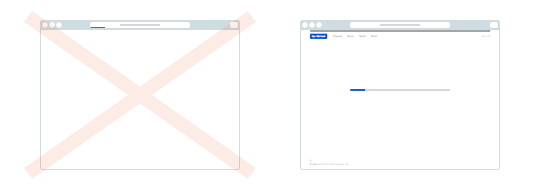A proposal for custom website loaders: loading.html
In a browser, when you enter a website address and press Enter, the first thing you see is white screen — no matter how fast your internet connection is. When you launch an app on an iPhone, you see the app immediately — no matter how old your phone is and how slow the app is. The trick is that every iPhone app includes a screenshot of its own initial state. Usually it is the app’s first screen without any content.
The browsers could copy the iPhone’s behaviour to improve the perceived speed of the web. In addition to the real page, a web server could serve an HTML file with a temporary content to show while the real page is loading. We’ll call it loading.html, but it could be anything pointed to by a link tag.
When the user goes to a site for the first time, the browser loads it in a regular manner. But if it figures out loading.html is available, it downloads the file and saves it locally. When the site is open again, the browser renders loading.html immediately and then replaces it with the real content when it becomes available.
This is not caching: browser shows loading.html while, not instead of loading the real page. And it will reload this file when it changes, like any other resource.
The difference between nothing and something is huge: immediate feedback, even approximate, is one of the main things that make user interface great. Enter:

The following aspects of loading.html should be considered:
- External resources. It seems sensible to disallow usage of any external resources for the file. They defeat the purpose of the file: the browser should not spend any time loading images or fonts for this temporary screen (which, hopefully, will be visible for only a second). The browser could cache those, but this may become a debugging nightmare. Embed all the styles, scripts and images — or make do without them.
- File size. Since a browser should store this file for every site you’ve visited, the file should be small. Also, its loading should not tax the visitors who open your site only once.
- Interaction and continuity. Interaction with a page that can vanish and get replaced with another one any moment seems strange. At first I though that it should be completely prohibited: no links, no listening to JavaScript events. But then I thought, what if I put a site’s menu in loading.html? If a user clicks a link, the browser could switch to loading it (it, by the way, could have its own loading.html, see also Scope). But badly implemented this could be frustrating. Say, a user is typing a search query into an input of loading.html when it gets replaced with a real page. The browser must make sure the typed letters are not dropped and the caret position is maintained.
- Progress information. It would make sense for loading.html to want to display a spinner or a progress bar itself instead of relying on the browser. For this to work, the progress information should be available to it. A way to implement this would be with an event sent to the page, i.e. onLoadingProgress (in which case disallowing all events is not an option).
- Location. From the point of view of the scripts on the loading.html page, its location should probably be the same as for the real page it’s temporarily replacing (even though in reality, obviously, loading.html was loaded from another URL).
- Cookies and localStorage. These should probably be available to loading.html as for the real page also. A use case would be showing the name of the signed-in user right on the loading.html page.
- Scope. A loading.html page might want to specify the scope of real pages it works as a loader to: only the one it is linked to, a range of pages, all pages on the given domain name.
- Expiry. A loading.html page might want to specify its expiry date.
- The switch. When should loading.html be replaced by the real page? Waiting for the full page to load is surely not optimal. Perhaps, a browser should use the same heuristics it uses now to start displaying a page when following a link. But I would consider giving a loading.html-aware pages some additional control over it.
I don’t have experience with Offline Web Applications APIs, but going by the description, I assume at least some of the described behaviour could be implemented with them. It would, however, be too complicated for anyone to bother.
This feature will probably be abused by some designers to show splash screens and ads. That’s not a problem. On the iPhone, some apps also show splash screens, and though this sucks, in no way is it a reason to remove the feature (actually, if we remove every feature that has a capacity of being abused, we’ll remain with nothing).
I’ve long been concerned with how web pages look and behave during loading, as you may have guessed looking at Emerge.js (just updated, by the way). There is a lot we can do as front-end developers. But to make things significantly better, help from the browser vendors would be required.
